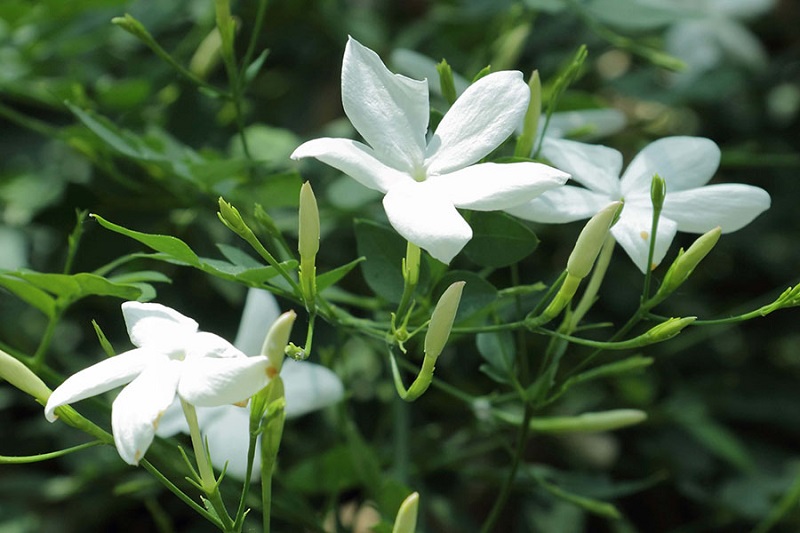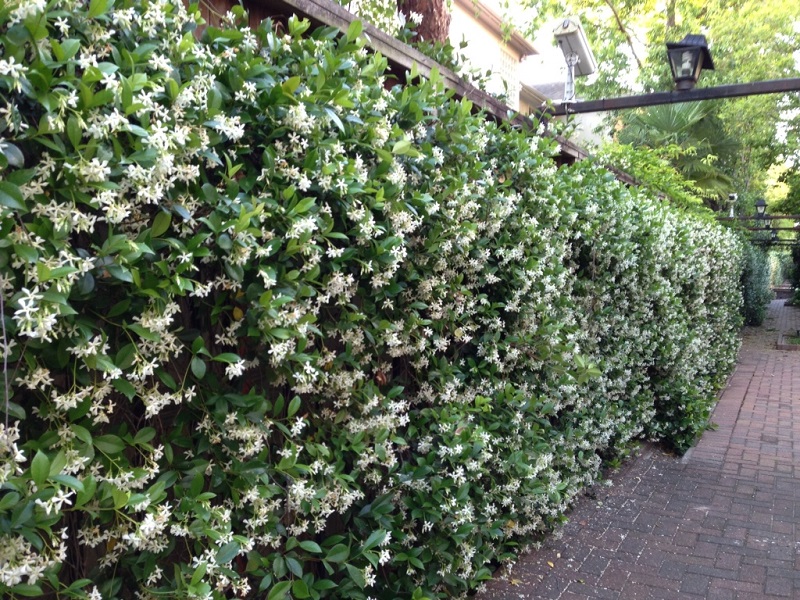Jasminum officinale, commonly known as the common jasmine or poet’s jasmine, is a striking and versatile plant celebrated for its fragrant flowers and ornamental beauty. Native to South Asia but now cultivated worldwide, this species belongs to the olive family (Oleaceae) and is renowned for its role in gardens, perfumery, and traditional medicine. This article delves into the botanical characteristics, cultivation practices, uses, and cultural significance of Jasminum officinale, offering a comprehensive guide for enthusiasts and cultivators alike.
Botanical Description
Physical Appearance
Leaves: Jasminum officinale features pinnate leaves with 5-9 leaflets. The leaflets are dark green and glossy, arranged oppositely along the stem. This arrangement enhances the plant’s lush, verdant appearance.
Flowers: The plant produces fragrant flowers that are typically white or yellowish. These flowers have a tubular shape and a star-like structure, often clustered in axillary or terminal inflorescences. The sweet scent of the blooms is one of the plant’s most distinguishing features.
Fruit: The fruit of Jasminum officinale is a small, smooth berry that turns black when ripe. Although not as prominent as the flowers, the fruit contributes to the plant’s overall aesthetic appeal.

Habitat and Distribution
Native Range
Jasminum officinale is originally native to South Asia, with its primary range including India, Pakistan, and Nepal. It thrives in the warm, tropical to subtropical climates of this region.
Cultivated Regions
Today, Jasminum officinale is cultivated globally, particularly in tropical and subtropical regions. Its adaptability allows it to grow in a variety of soil types and climates, making it a popular choice for gardeners worldwide.
Growth Conditions
Soil: The plant prefers well-drained soil rich in organic matter. While it is relatively tolerant of different soil types, optimal growth is achieved in nutrient-rich environments.
Light: Jasminum officinale flourishes in full sun to partial shade. Adequate sunlight is crucial for robust growth and flowering.
Watering: Regular watering is essential, though care should be taken to avoid waterlogging, which can lead to root rot.
Cultivation and Care
Planting
Best Time: The ideal times to plant Jasminum officinale are spring or fall. These seasons provide favorable conditions for root establishment and growth.
Planting Depth: When planting, ensure the depth is consistent with the nursery pot to avoid disrupting the plant’s root system.
Maintenance
Pruning: Regular pruning is necessary to control the plant’s growth and shape. Prune after flowering to encourage new growth and maintain an attractive form.
Fertilization: Apply a balanced fertilizer during the growing season to support healthy development and prolific flowering.
Pests/Diseases: Common issues include aphids and mildew. Monitoring and addressing these problems promptly will help maintain plant health.
Uses
Ornamental
Jasminum officinale is widely used as an ornamental plant in gardens. It is ideal for covering trellises, fences, and as ground cover. The fragrant blooms add aesthetic and sensory appeal to any garden setting.
Perfumery
Essential Oils: The plant’s essential oils are extracted for use in perfumes and cosmetics. The sweet, floral fragrance of Jasminum officinale is a staple in high-end fragrances and aromatherapy.
Aroma: The distinctive scent of the jasmine flowers contributes significantly to the plant’s popularity in the fragrance industry.

Traditional Medicine
Uses: In traditional medicine, Jasminum officinale is used to treat various ailments such as headaches and anxiety. Its therapeutic properties are harnessed in infusions, extracts, and topical applications.
Preparation: Medicinal preparations may include teas, tinctures, or essential oil applications, depending on the intended use.
Cultural and Symbolic Significance
Historical Use
Throughout history, Jasminum officinale has been utilized in rituals and as a symbol of love and beauty. Its fragrant blooms have adorned ceremonies and cultural practices across various civilizations.
Modern Significance
Cultural Symbolism: In modern times, the plant represents beauty, elegance, and grace in numerous cultures. It is often featured in festivals and ceremonies, particularly in South Asia, where it holds significant cultural value.
Conservation and Environmental Impact
Conservation Status
Jasminum officinale is not currently endangered and is considered common and widely cultivated. Its robust nature and adaptability contribute to its stable conservation status.
Environmental Benefits
Erosion Control: The extensive root system of Jasminum officinale helps stabilize soil, making it beneficial for erosion control.
Biodiversity: The plant supports local biodiversity by providing habitat and food for various pollinators, including bees and butterflies.
Conclusion
Jasminum officinale, with its captivating fragrance and ornamental charm, is a valuable addition to gardens, perfumeries, and traditional medicine cabinets. Its adaptability, combined with its aesthetic and functional uses, ensures its continued popularity and relevance. As we appreciate its beauty and benefits, it is also crucial to recognize its environmental and cultural significance, fostering a deeper connection to this remarkable plant. Whether you’re an avid gardener, a perfume enthusiast, or interested in traditional remedies, Jasminum officinale offers a wealth of value and versatility.
